New York City – No, it isn’t the latest Japanese horror flick. It’s just part of a lively debate about just what in the world is the “white tuna” that has popped up for the last couple of years on sushi bars from coast to coast. I’m afraid I’m not going to be able to resolve it. There’s an odd sort of fun to watching online (and the occasional in person) debates and arguments over just what slice of fish has been eaten.
Sometimes my favorite sushi chef calls it Shiromaguro, which most folk seem to think is Albacore, and sometimes he calls it Mutsu, which as best I can determine is the Japanese Bluefish Scombrops boops (I threw in the latin just because I love the name). Now, most albacore that I’ve worked with has a pale pink flesh, and occasionally, so does my sushi. Most bluefish I’ve worked with have very dark, oily flesh, which my sushi doesn’t. Most of the time the sushi in front of me is nearly pure white, possibly just tinged with pink, but then, at other sushi bars, I sometimes get something much more “tuna” looking.
I’ve seen assertions that it’s Chilean Sea Bass, or a close relative, and texturally and flavor-wise, I’d have to say that doesn’t seem far off. However, I’ve also had supposed Chilean Sea Bass (which is a misnomer for the Patagonian Toothfish, but sells it better) sushi at the same sushi bar, at the same time, and it wasn’t the same. Neither are other sea basses that have been suggested.
There have also been claims of the Escolar. Now, Escolar, which is sometimes marketed under other names like “snake mackerel”, is an odd little fish. It’s flesh has been described as tasting like what butter would taste like if butter were a fish. This, unfortunately, is due to the presence of “waxy esters” in it’s body… essentially fat that acts much like the famed Olestra… with similarly backsided explosive results. I.e., you get the runs. Though the flavor description is pretty accurate for most white tuna I’ve eaten, I’ve never gotten that side effect, nor has anyone I know, from eating white tuna.
 A quick Google image search this morning wasn’t much more enlightening. “Shiromaguro” brought up three pictures of fairly reddish sushi, looking much like any tuna. “Shiro maguro” brought up several possibilites, including both albacore and bonito. “Mutsu” by itself was a mistake – having forgotten about Mutsu Apples and not having considered the names of characters in, shall we say, “graphic novels”.
A quick Google image search this morning wasn’t much more enlightening. “Shiromaguro” brought up three pictures of fairly reddish sushi, looking much like any tuna. “Shiro maguro” brought up several possibilites, including both albacore and bonito. “Mutsu” by itself was a mistake – having forgotten about Mutsu Apples and not having considered the names of characters in, shall we say, “graphic novels”.  However, “Mutsu sushi” brought up a picture of a nearly glowing vermillion pink piece of sushi. And, “white tuna sushi” brought up a variety of sushi platters, including one picture of the nearly pure white version.
However, “Mutsu sushi” brought up a picture of a nearly glowing vermillion pink piece of sushi. And, “white tuna sushi” brought up a variety of sushi platters, including one picture of the nearly pure white version.
 The best I can offer on this debate is that, given the range of color and texture that I’ve seen in different sushi bars, and that different people have described, is that the term is used by sushi chefs to refer to a variety of different species that just happen to look pale and don’t fit another common name. When asked about why he sometimes calls it one thing and sometimes another, my fave sushi bar chef shrugs his shoulders and says, “white tuna sells.”
The best I can offer on this debate is that, given the range of color and texture that I’ve seen in different sushi bars, and that different people have described, is that the term is used by sushi chefs to refer to a variety of different species that just happen to look pale and don’t fit another common name. When asked about why he sometimes calls it one thing and sometimes another, my fave sushi bar chef shrugs his shoulders and says, “white tuna sells.”
In my favorite restuarant, mutsu is black marlin, lightly seared, and with a hearty and earthy non-fatty taste.
[…] one and then make the plate – and ended up with a twelve piece plate of salmon, red tuna, white tuna (which I’ve only seen here once before at a fish market, and offered once at a sushi bar but […]